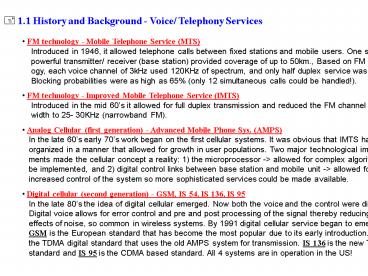1.1 History and Background Voice Telephony Services - PowerPoint PPT Presentation
1 / 2
Title:
1.1 History and Background Voice Telephony Services
Description:
powerful transmitter/ receiver (base station) provided coverage of up to 50km. ... Several network operators, such as Sprint and A. T.& T., have started to market PCS ... – PowerPoint PPT presentation
Number of Views:39
Avg rating:3.0/5.0
Title: 1.1 History and Background Voice Telephony Services
1
- 1.1 History and Background - Voice/ Telephony
Services - FM technology - Mobile Telephone Service (MTS)
- Introduced in 1946, it allowed
telephone calls between fixed stations and mobile
users. One single - powerful transmitter/ receiver (base
station) provided coverage of up to 50km., Based
on FM technol- - ogy, each voice channel of 3kHz used
120KHz of spectrum, and only half duplex service
was available. - Blocking probabilities were as high
as 65 (only 12 simultaneous calls could be
handled!). - FM technology - Improved Mobile Telephone
Service (IMTS) - Introduced in the mid 60s it allowed
for full duplex transmission and reduced the FM
channel band- - width to 25- 30KHz (narrowband FM).
- Analog Cellular (first generation) - Advanced
Mobile Phone Sys. (AMPS) - In the late 60s early 70s work began
on the first cellular systems. It was obvious
that IMTS had to be - organized in a manner that allowed for
growth in user populations. Two major
technological improve- - ments made the cellular concept a
reality 1) the microprocessor - allowed for
complex algorithms to - be implemented, and 2) digital control
links between base station and mobile unit -
allowed for - increased control of the system so
more sophisticated services could be made
available.
2
- Personal Communications Systems (third
generation) - DECT, DCS1800 - In the early 90s the success of cellular
telephony was obvious and spurred a major effort
in defining - the next generation cellular systems that would
provide ubiquitous access to communications
services - any where, anytime for any application. The
Europeans, motivated by the tremendous success of
GSM - defined a new enhanced GSM, called DCS 1800 . It
will carry both voice and data streams. In
addition - they developed a common air interface called DECT
that will support both data and voice
transmission - at 32kbps. In the US the efforts have not
produced any tangible results as yet, many
competing stan- - dards are being pushed and the FCC has taken no
major role in trying to focus the efforts and
producing - a single standard. Several network operators,
such as Sprint and A. T. T., have started to
market PCS - services. These services consist of digital
cellular in addition to paging and voice mail.
The cell sizes - are very small, allowing the portables to be
small too and lightweight. However what is being
offered is - still a far cry from what was promised for PCS.
It remains to be seen how soon true PCS will be
offered - and what it will be based on.































